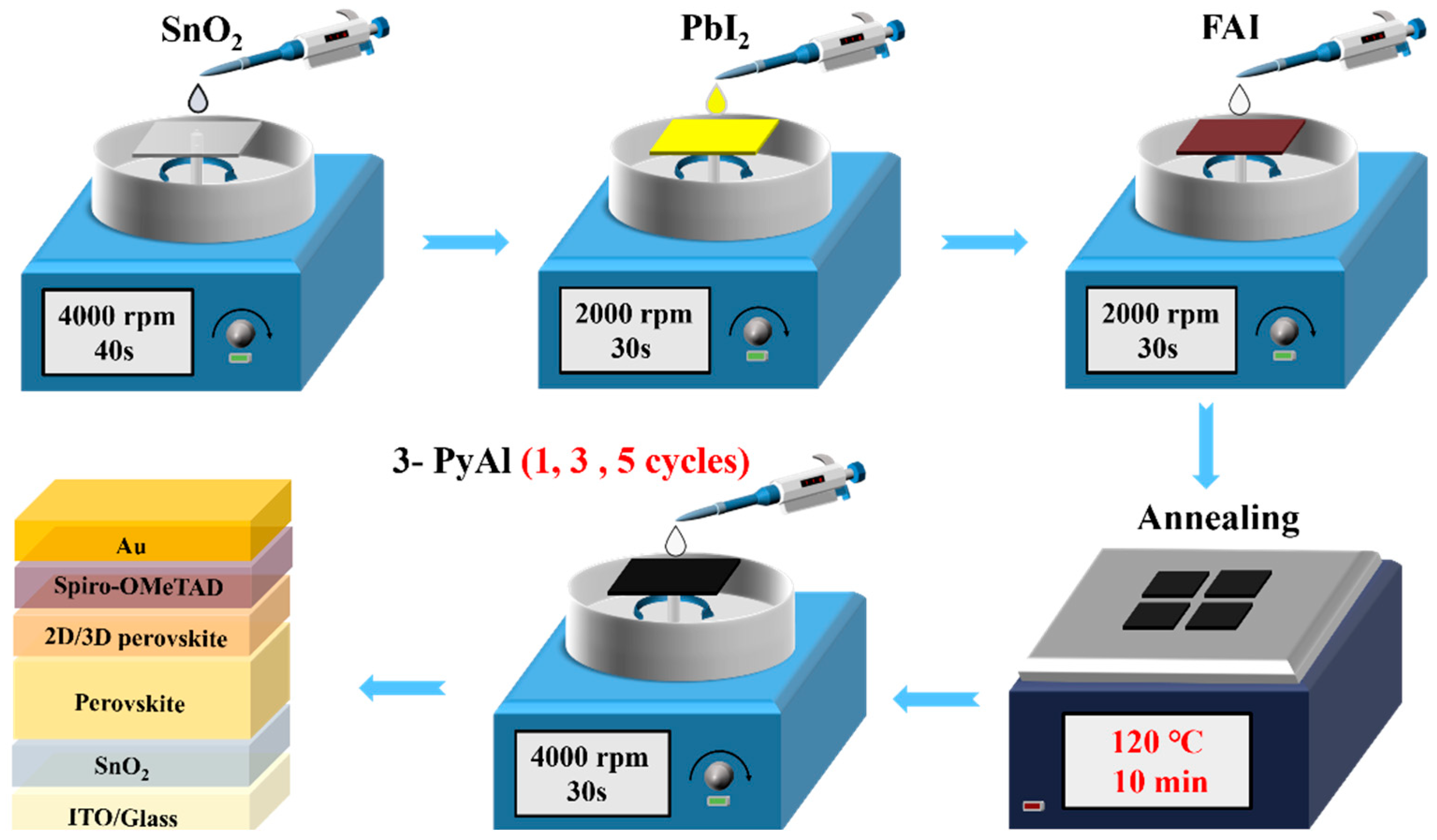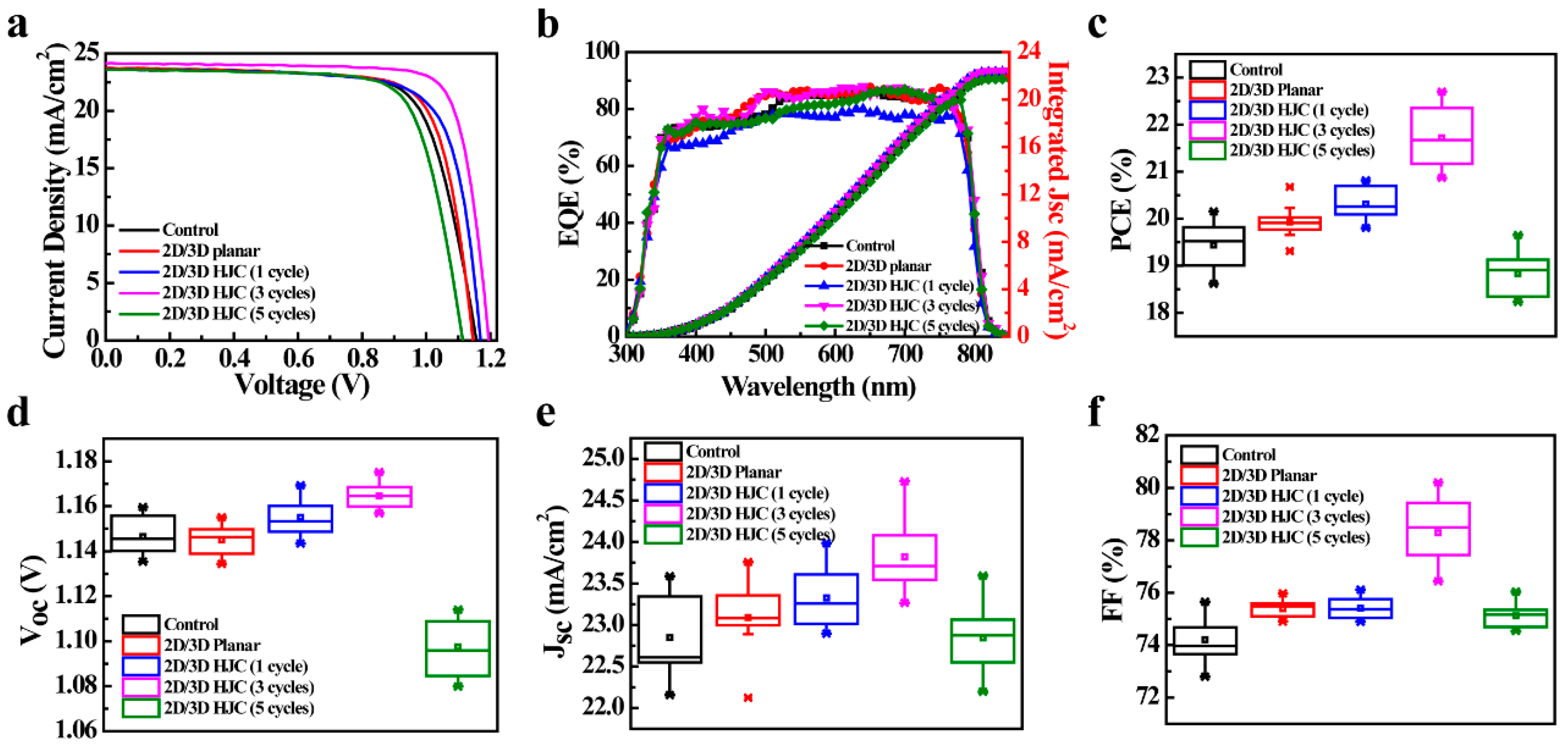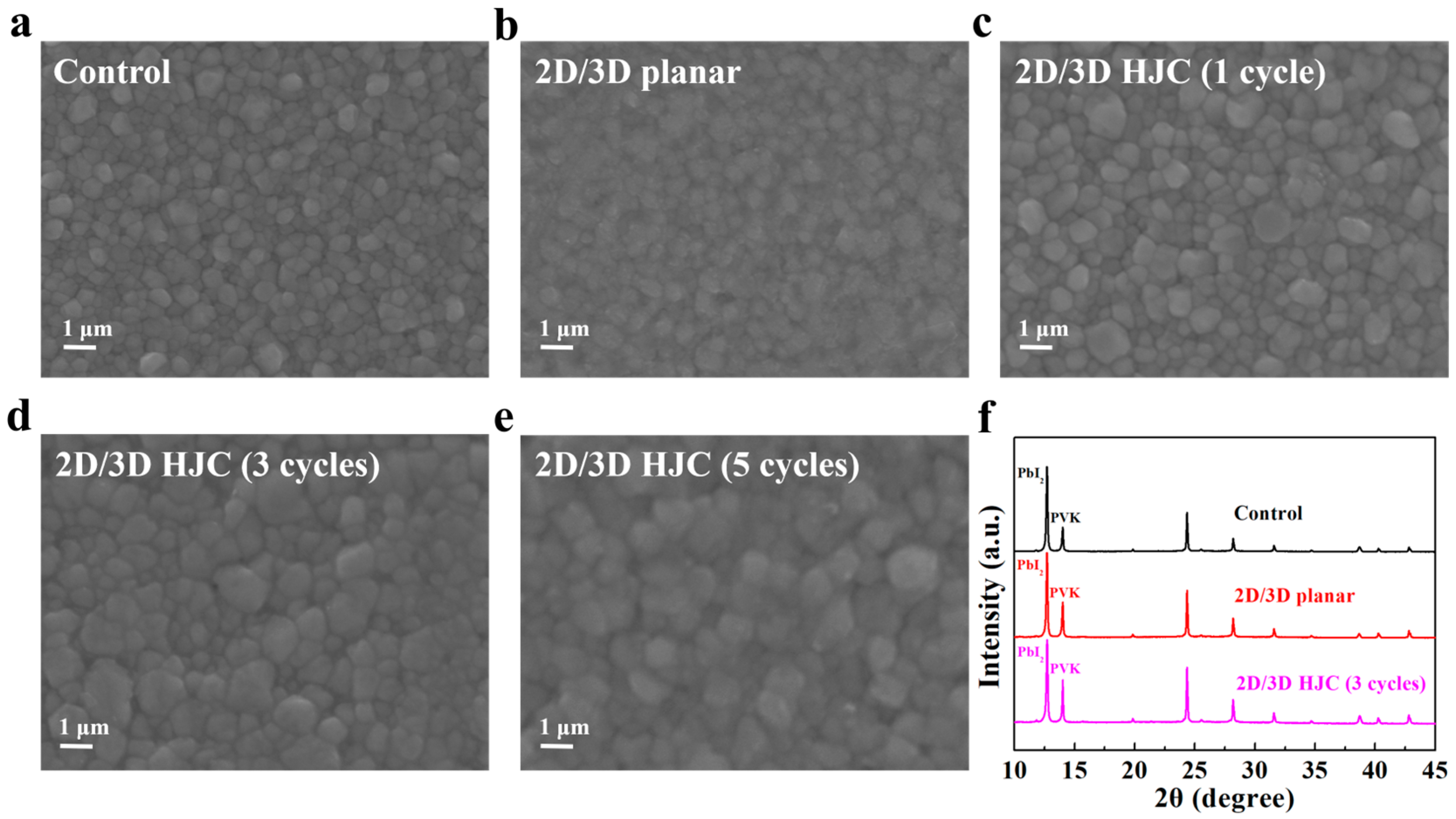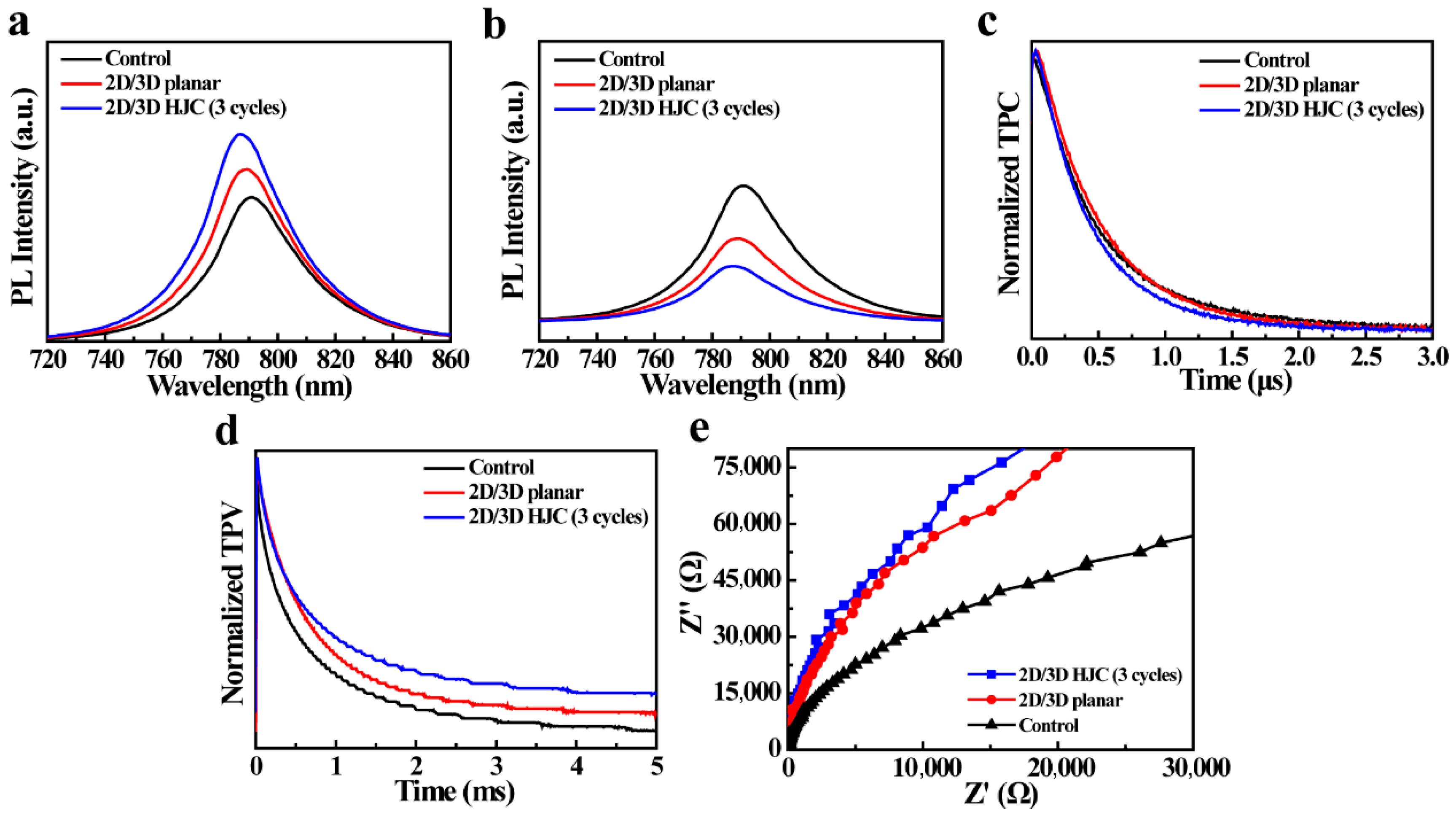Multi-Step Spin-Coating with In Situ Crystallization for Growing 2D/3D Perovskite Films
Abstract
1. Introduction
2. Experiment
2.1. Device Fabrication
2.2. Characterization
3. Results and Discussion
4. Conclusions
Supplementary Materials
Author Contributions
Funding
Data Availability Statement
Conflicts of Interest
Correction Statement
References
- Kojima, A.; Teshima, K.; Shirai, Y.; Miyasaka, T. Organometal halide perovskites as visible-light sensitizers for photovoltaic cells. J. Am. Chem. Soc. 2009, 131, 6050–6051. [Google Scholar] [CrossRef]
- Min, H.; Lee, D.Y.; Kim, J.; Kim, G.; Lee, K.S.; Kim, J.; Paik, M.J.; Kim, Y.K.; Kim, K.S.; Kim, M.G.; et al. Perovskite solar cells with atomically coherent interlayers on SnO2 electrodes. Nature 2021, 598, 444–450. [Google Scholar] [CrossRef] [PubMed]
- National Renewable Energy Laboratory (NREL). Best Research-Cell Efficiency Chart. Available online: https://www.nrel.gov/pv/cell-efficiency.html (accessed on 1 December 2023).
- Aristidou, N.; Sanchez-Molina, I.; Chotchuangchutchaval, T.; Brown, M.; Martinez, L.; Rath, T.; Haque, S.A. The role of oxygen in the degradation of methylammonium lead trihalide perovskite photoactive layers. Angew. Chem. Int. Ed. 2015, 54, 8208–8212. [Google Scholar] [CrossRef] [PubMed]
- Wang, Z.; Lin, Q.; Chmiel, F.P.; Sakai, N.; Herz, L.M.; Snaith, H.J. Efficient ambient-air-stable solar cells with 2D-3D heterostructured butylammonium-caesium-formamidinium lead halide perovskites. Nat. Energy 2017, 2, 17135. [Google Scholar] [CrossRef]
- Yuan, Y.; Huang, J. Ion migration in organometal trihalide perovskite and its impact on photovoltaic efficiency and stability. Acc. Chem. Res. 2016, 49, 286–293. [Google Scholar] [CrossRef]
- Leguy, A.M.A.; Hu, Y.; Campoy-Quiles, M.; Alonso, M.I.; Weber, O.J.; Azarhoosh, P.; Schifgaarde, M.V.; Weller, M.T.; Bein, T.; Nelson, J.; et al. Reversible hydration of CH3NH3PbI3 in films, single crystals, and solar cells. Chem. Mater. 2015, 27, 3397–3407. [Google Scholar] [CrossRef]
- Shi, L.; Yuan, H.; Zhang, Y.; Sun, X.; Duan, L.; Li, Q.; Huang, Z.; Ban, X.; Zhang, D. Novel C3N4-assisted bilateral interface engineering for efficient and stable perovskite solar cells. Langmuir 2022, 38, 12390–12398. [Google Scholar] [CrossRef]
- Erdi, A.; Akin, S. Poly(N,N′-bis-4-butylphenyl-N,N′-bisphenyl)benzidine-based interfacial passivation strategy promoting efficiency and operational stability of perovskite solar cells in regular architecture. Adv. Mater. 2021, 33, 2006087. [Google Scholar]
- Sidhik, S.; Wang, Y.; Siena, M.D.; Asadpour, R.; Torma, A.J.; Terlier, T.; Ho, K.; Li, W.; Puthirath, A.B.; Shuai, X.; et al. Deterministic fabrication of 3D/2D perovskite bilayer stacks for durable and efficient solar cells. Science 2022, 377, 1425–1430. [Google Scholar] [CrossRef]
- Grancini, G.; Roldán-Carmona, C.; Zimmermann, I.; Mosconi, E.; Lee, X.; Martineau, D.; Narbey, S.; Oswald, F.; De Angelis, F.; Graetzel, M.; et al. One-Year stable perovskite solar cells by 2D/3D interface engineering. Nat. Commun. 2017, 8, 15684. [Google Scholar] [CrossRef]
- Lin, Y.; Bai, Y.; Fang, Y.; Wang, Q.; Deng, Y.; Huang, J. Suppressed ion migration in low-dimensional perovskites. ACS Energy Lett. 2017, 2, 1571–1572. [Google Scholar] [CrossRef]
- Lin, Y.; Bai, Y.; Fang, Y.; Chen, Z.; Yang, S.; Zheng, X.; Tang, S.; Liu, Y.; Zhao, J.; Huang, J. Enhanced thermal stability in perovskite solar cells by assembling 2D/3D stacking structures. J. Phys. Chem. Lett. 2018, 9, 654–658. [Google Scholar] [CrossRef] [PubMed]
- Luo, W.; Wu, C.; Wang, D.; Zhang, Y.; Zhang, Z.; Qi, X.; Zhu, N.; Guo, X.; Qu, B.; Xiao, L.; et al. Efficient and stable perovskite solar cell with high open-circuit voltage by dimensional interface modification. ACS Appl. Mater. Interfaces 2019, 11, 9149–9155. [Google Scholar] [CrossRef] [PubMed]
- Cao, H.; Li, T.; Zhao, L.; Qiang, Y.; Zheng, X.; Dai, S.; Chen, Y.; Zhu, Y.; Zhao, L.; Cai, R.; et al. Triphenylamine-based hole-transporting ligands for 2D/3D FAPbI3 perovskite solar cells. ACS Energy Lett. 2025, 10, 2017–2025. [Google Scholar] [CrossRef]
- Zhang, J.; Chu, L.; Liu, T.; Tian, B.; Chu, W.; Sun, X.; Nie, R.; Zhang, W.; Zhang, Z.; Zhao, X.; et al. Engineering Spacer Conjugation for Efficient and Stable 2D/3D Perovskite Solar Cells and Modules. Angew. Chem. Int. Ed. 2025, 64, e202413303. [Google Scholar] [CrossRef]
- Li, S.; Hu, L.; Zhang, C.; Wu, Y.; Liu, Y.; Sun, Q.; Cui, Y.; Hao, Y.; Wu, Y. In situ growth of a 2D/3D mixed perovskite interface layer by seed-mediated and solvent-assisted Ostwald ripening for stable and efficient photovoltaics. J. Mater. Chem. C 2020, 8, 2425–2435. [Google Scholar] [CrossRef]
- Chen, P.; Bai, Y.; Wang, S.; Lyu, M.; Yun, J.H.; Wang, L. In situ growth of 2D perovskite capping layer for stable and efficient perovskite solar cells. Adv. Funct. Mater. 2018, 28, 1707923. [Google Scholar] [CrossRef]
- Wang, T.; Bi, L.; Yang, L.; Zeng, Z.; Ji, X.; Hu, Z.; Tsang, S.T.; Yip, H.L.; Fu, Q.; Jen, A.K.Y.; et al. Dimensional Regulation from 1D/3D to 2D/3D of Perovskite Interfaces for Stable Inverted Perovskite Solar Cells. J. Am. Chem. Soc. 2024, 146, 7555–7564. [Google Scholar] [CrossRef]
- Nie, W.; Tsai, H.; Asadpour, R.; Blancon, J.C.; Neukirch, A.J.; Gupta, G.; Crochet, J.J.; Chhowalla, M.; Tretiak, S.; Alam, M.A.; et al. High-efficiency solution-processed perovskite solar cells with millimeter-scale grains. Science 2015, 347, 522–525. [Google Scholar] [CrossRef]
- Yang, M.; Zhou, Y.; Zeng, Y.; Jiang, C.S.; Padture, N.P.; Zhu, K. Square-centimeter solution-processed planar CH3NH3PbI3 perovskite solar cells with efficiency exceeding 15%. Adv. Mater. 2015, 27, 6363–6370. [Google Scholar] [CrossRef]
- Zhou, T.; Lai, H.; Liu, T.; Lu, D.; Wan, X.; Zhang, X.; Liu, Y.; Chen, Y. Highly efficient and stable solar cells based on crystalline oriented 2D/3D hybrid perovskite. Adv. Mater. 2019, 31, 1901242. [Google Scholar] [CrossRef]
- Jung, E.H.; Jeon, N.J.; Park, E.Y.; Moon, C.S.; Shin, T.J.; Yang, T.Y.; Noh, J.H.; Seo, J. Efficient, stable and scalable perovskite solar cells using poly(3-hexylthiophene). Nature 2019, 567, 511–515. [Google Scholar] [CrossRef]
- Bi, D.; Yi, C.; Luo, J.; Décoppet, J.D.; Zhang, F.; Zakeeruddin, S.M.; Li, X.; Hagfeldt, A.; Grätzel, M. Polymer-templated nucleation and crystal growth of perovskite films for solar cells with efficiency greater than 21%. Nat. Energy 2016, 1, 16142. [Google Scholar] [CrossRef]
- Mahmud, M.A.; Elumalai, N.K.; Upama, M.B.; Wang, D.; Haque, F.; Wright, M.; Xu, C.; Uddin, A. Controlled nucleation assisted restricted volume solvent annealing for stable perovskite solar cells. Sol. Energy Mater. Sol. Cells 2017, 167, 70–86. [Google Scholar] [CrossRef]
- DeQuilettes, D.W.; Vorpahl, S.M.; Stranks, S.D.; Nagaoka, H.; Eperon, G.E.; Ziffer, M.E.; Snaith, H.J.; Ginger, D.S. Impact of microstructure on local carrier lifetime in perovskite solar cells. Science 2015, 348, 683–686. [Google Scholar] [CrossRef] [PubMed]
- Motti, S.G.; Kober-Czerny, M.; Righetto, M.; Holzhey, P.; Smith, J.; Kraus, H.; Snaith, H.J.; Johnston, M.B.; Herz, L.M. Exciton formation dynamics and band-like free charge-carrier transport in 2D metal halide perovskite semiconductors. Adv. Funct. Mater. 2023, 33, 2300363. [Google Scholar] [CrossRef]
- Correa-Baena, J.P.; Tress, W.; Domanski, K.; Anaraki, E.H.; Turren-Cruz, S.H.; Roose, B.; Boix, P.P.; Grätzel, M.; Saliba, M.; Abate, A.; et al. Identifying and suppressing interfacial recombination to achieve high open-circuit voltage in perovskite solar cells. Energy Environ. Sci. 2017, 10, 1207–1212. [Google Scholar] [CrossRef]
- Wu, B.; Nguyen, H.T.; Ku, Z.; Han, G.; Giovanni, D.; Mathews, N.; Fan, H.J.; Sum, T.C. Discerning the surface and bulk recombination kinetics of organic–inorganic halide perovskite single crystals. Adv. Energy Mater. 2016, 6, 1600551. [Google Scholar] [CrossRef]
- Leal, D.A.A.; Shaji, S.; Avellaneda, D.A.; Martínez, J.A.A.; Krishnan, B. In situ incorporation of laser ablated PbS nanoparticles in CH3NH3PbI3 films by spin-dip coating and the subsequent effects on the planar junction CdS/CH3NH3PbI3 solar cells. Appl. Surf. Sci. 2020, 508, 144899. [Google Scholar] [CrossRef]
- Tress, W.; Marinova, N.; Moehl, T.; Zakeeruddin, S.M.; Nazeeruddin, M.K.; Grätzel, M. Understanding the rate-dependent J–V hysteresis, slow time component, and aging in CH3NH3PbI3 perovskite solar cells: The role of a compensated electric field. Energy Environ. Sci. 2015, 8, 995–1004. [Google Scholar] [CrossRef]
- Zarazua, I.; Bisquert, J.; Garcia-Belmonte, G. Light-induced space-charge accumulation zone as photovoltaic mechanism in perovskite solar cells. J. Phys. Chem. Lett. 2016, 7, 525–528. [Google Scholar] [CrossRef]
- Zhou, R.; Chen, Y.; Zhou, L.; Yao, Y.; Liu, Y.; Wang, C.; Niu, L.; Chen, L. Inhibiting hysteresis and optimizing the performance of perovskite solar cells. Sol. Energy Mater. Sol. Cells 2024, 264, 112616. [Google Scholar] [CrossRef]
- Aftab, S.; Ali, Z.; Hussain, I.; Assiri, M.A.; Rubab, N.; Ozel, F.; Akman, E. Perovskite Quantum Dots: Fabrication, Degradation, and Enhanced Performance Across Solar Cells, Optoelectronics, and Quantum Technologies. Carbon Energy 2025, e70018. [Google Scholar] [CrossRef]





Disclaimer/Publisher’s Note: The statements, opinions and data contained in all publications are solely those of the individual author(s) and contributor(s) and not of MDPI and/or the editor(s). MDPI and/or the editor(s) disclaim responsibility for any injury to people or property resulting from any ideas, methods, instructions or products referred to in the content. |
© 2025 by the authors. Licensee MDPI, Basel, Switzerland. This article is an open access article distributed under the terms and conditions of the Creative Commons Attribution (CC BY) license (https://creativecommons.org/licenses/by/4.0/).
Share and Cite
Liu, M.; Hao, Y.; Ma, F.; Zhu, P.; Wu, H.; Li, Z.; Niu, W.; Huang, Y.; Huangfu, G.; Li, J.; et al. Multi-Step Spin-Coating with In Situ Crystallization for Growing 2D/3D Perovskite Films. Crystals 2025, 15, 774. https://doi.org/10.3390/cryst15090774
Liu M, Hao Y, Ma F, Zhu P, Wu H, Li Z, Niu W, Huang Y, Huangfu G, Li J, et al. Multi-Step Spin-Coating with In Situ Crystallization for Growing 2D/3D Perovskite Films. Crystals. 2025; 15(9):774. https://doi.org/10.3390/cryst15090774
Chicago/Turabian StyleLiu, Meihong, Yafeng Hao, Fupeng Ma, Pu Zhu, Huijia Wu, Ziwei Li, Wenyu Niu, Yujie Huang, Guitian Huangfu, Junye Li, and et al. 2025. "Multi-Step Spin-Coating with In Situ Crystallization for Growing 2D/3D Perovskite Films" Crystals 15, no. 9: 774. https://doi.org/10.3390/cryst15090774
APA StyleLiu, M., Hao, Y., Ma, F., Zhu, P., Wu, H., Li, Z., Niu, W., Huang, Y., Huangfu, G., Li, J., Li, F., Yu, J., Zhang, L., Li, T., Lei, C., & Liang, T. (2025). Multi-Step Spin-Coating with In Situ Crystallization for Growing 2D/3D Perovskite Films. Crystals, 15(9), 774. https://doi.org/10.3390/cryst15090774






